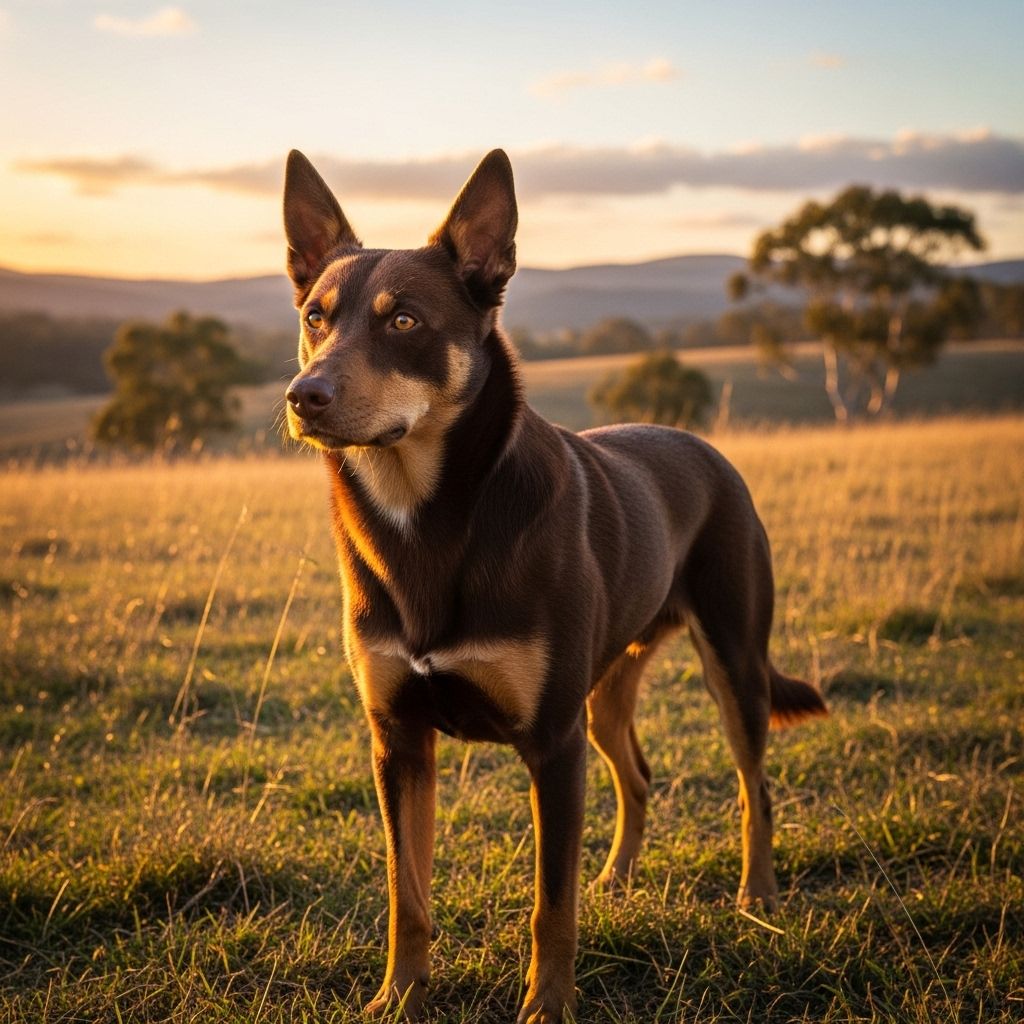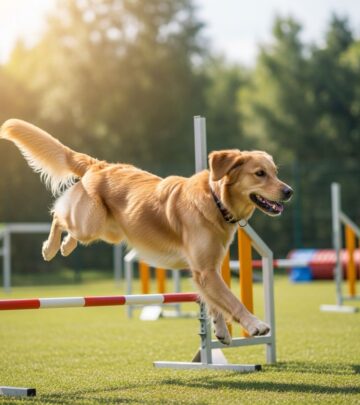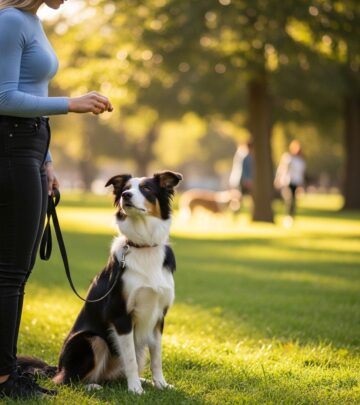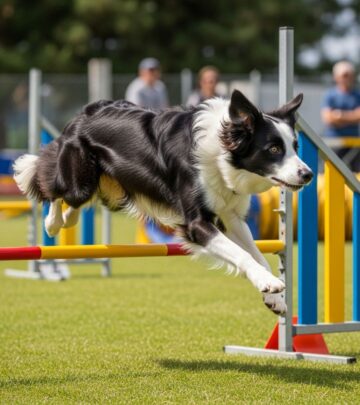Australian Kelpie: Ultimate Guide To Characteristics And Care
Discover the energetic, intelligent Australian Kelpie: a working dog with boundless stamina and loyalty

Image: HearthJunction Design Team
Australian Kelpie: Dog Breed Characteristics & Care
The Australian Kelpie stands out as one of the world’s premier herding dogs, renowned for its extraordinary intelligence, boundless energy, and exceptional work ethic. These medium-sized dogs possess an athletic build that perfectly complements their seemingly tireless nature. With their keen eyes and alert expression, Kelpies are always ready for action, embodying the hardworking spirit that made them indispensable on Australian farms and ranches.
Known for their athletic builds and energetic personalities, these dogs are highly intelligent and driven. They thrive on hard work and need tasks to stay mentally stimulated and physically satisfied. While their working capabilities are legendary, potential owners should understand that these traits translate to specific needs in a family setting.
Breed Overview
| Characteristic | Details |
|---|---|
| Weight | 30 to 45 pounds |
| Height | 15 to 20 inches |
| Coat | Short double coat |
| Coat Colors | Black, black and tan, red, red and tan, chocolate, fawn |
| Lifespan | 10 to 13 years |
Australian Kelpie Characteristics
The Australian Kelpie possesses a unique set of characteristics that make them exceptional working dogs but can present challenges in a typical home environment. Understanding these traits is crucial before deciding if a Kelpie is the right addition to your family.
Temperament
Australian Kelpies are renowned for their intelligence, loyalty, and unwavering work ethic. These dogs form strong bonds with their owners and are often described as ‘velcro dogs’ for their desire to be close to their people. While affectionate with family members, they may show some reserve around strangers, making them excellent watchdogs.
Their herding instincts run deep, and without proper training and outlets for their energy, they may attempt to herd children, other pets, or even moving vehicles. This behavior stems from their working heritage and requires appropriate management and redirection.
Kelpies are exceptionally alert and responsive, making them highly trainable. They thrive on mental challenges and excel in various dog sports, including agility, obedience, and herding trials. Their problem-solving abilities and eagerness to please make training sessions productive and engaging.
Exercise Needs
Perhaps the most critical consideration for potential Kelpie owners is the breed’s substantial exercise requirements. These dogs were developed to work tirelessly in harsh conditions, often covering vast distances while herding livestock. This working heritage translates to a dog with seemingly boundless energy and stamina.
Australian Kelpies need significant daily physical activityâfar more than a casual walk around the block. Ideal exercise regimens include:
- Long, vigorous walks or jogs (at least 1-2 hours daily)
- Off-leash running in secure areas
- Fetch games that allow full sprinting
- Swimming sessions
- Hiking adventures
- Participation in dog sports like agility, flyball, or herding trials
Without adequate physical outlets, Kelpies often develop problematic behaviors stemming from frustration and pent-up energy. These can include excessive barking, destructive chewing, digging, and other unwanted activities.
Mental Stimulation Requirements
Equally important as physical exercise is mental stimulation. Australian Kelpies possess remarkable intelligence and problem-solving abilities that need regular engagement. Mental exercise is as crucial as physical activity for this breed’s well-being.
Effective mental stimulation can include:
- Advanced obedience training
- Puzzle toys and food dispensers
- Scent work and tracking activities
- Trick training
- Rotating new toys and challenges
Many Kelpie owners find that combining physical and mental exerciseâsuch as agility training or structured herding activitiesâprovides the ideal balance for these intelligent dogs.
Living Needs
Australian Kelpies can adapt to various living situations, provided their exercise and mental stimulation needs are met consistently. They generally do best in homes with secure, spacious yards where they can run and play safely. However, they can adapt to apartment living if given sufficient daily exercise and engagement.
These dogs typically do well with active families who enjoy outdoor activities and can incorporate their dog into various aspects of daily life. Kelpies form strong bonds with children and can make excellent family companions when properly socialized and trained.
Due to their herding instincts, early socialization with other pets is essential. While many Kelpies can learn to live harmoniously with cats and other dogs, their natural tendency to chase and herd requires management and training.
One consideration for urban dwellers is the Kelpie’s tendency to bark. These alert dogs may vocalize in response to unfamiliar sounds or activities, which can present challenges in close living quarters. Consistent training can help manage this behavior, but potential owners should be aware of this characteristic.
Care
Caring for an Australian Kelpie involves understanding their specific needs across various aspects of dog ownership. While generally healthy and relatively low-maintenance in terms of grooming, they require significant investment in training, exercise, and mental stimulation.
Grooming
One of the advantages of Australian Kelpies is their minimal grooming requirements. Their short double coat sheds moderately year-round, with seasonal heavy shedding periods. Regular brushing (1-2 times weekly) helps manage loose hair and distributes skin oils.
Baths are rarely needed unless the dog gets particularly dirty during outdoor adventures. Their natural coat has dirt-repelling qualities and tends to shed debris readily.
Other routine care includes:
- Regular nail trimming (every 3-4 weeks)
- Dental care including brushing and appropriate chew toys
- Ear checks and cleaning as needed
Training
Training is where Australian Kelpies truly shine. Their intelligence, eagerness to please, and work-oriented nature make them highly trainable. However, their intelligence also means they quickly become bored with repetitive drills or inconsistent handling.
Effective training approaches include:
- Positive reinforcement methods
- Consistency in commands and expectations
- Mental challenges that engage their problem-solving abilities
- Progressive training that builds on established skills
- Early and ongoing socialization
Harsh training methods are counterproductive with Kelpies, potentially damaging the trust bond between dog and handler. These sensitive dogs respond best to fair, clear communication and positive reinforcement.
Health
Australian Kelpies are generally robust and healthy dogs with relatively few breed-specific health concerns. Their working heritage has contributed to their hardiness, but like all breeds, they can be prone to certain conditions.
Health issues that may affect Kelpies include:
- Hip dysplasia
- Progressive retinal atrophy (PRA)
- Cerebellar abiotrophy
- Luxating patella
Responsible breeding practices, including appropriate health testing, help minimize these risks. Regular veterinary care, proper nutrition, and maintaining appropriate weight are essential components of keeping Kelpies healthy throughout their typically 10-13 year lifespan.
Diet and Nutrition
Australian Kelpies benefit from high-quality dog food appropriate for their age, size, and activity level. These active dogs often require more calories than similarly-sized but less active breeds. Working Kelpies, in particular, may need energy-dense nutrition to sustain their high activity levels.
Portion control and monitoring for healthy weight are important, as is ensuring access to fresh, clean water at all times. Many Kelpie owners find that feeding twice daily works well, though individual needs may vary based on age, activity level, and metabolism.
Consulting with a veterinarian about specific nutritional needs is recommended, especially for working dogs or those participating in intensive dog sports.
History and Background
The Australian Kelpie’s development is intrinsically tied to Australia’s sheep industry. These dogs emerged in the late 19th century when Australia’s vast stations (ranches) required efficient herding dogs capable of working independently in harsh conditions.
The breed developed from various British collie types imported to Australia, selected specifically for their ability to handle the challenging Australian climate and terrain. Contrary to some myths, DNA testing has disproven claims that Kelpies were crossed with dingoes.
The name “Kelpie” originated from a specific black and tan female dog who demonstrated exceptional herding abilities. Her descendants formed the foundation of what would become the recognized breed. Today, Australian Kelpies have been exported worldwide and continue to serve as valuable working partners on farms and ranches, while also excelling in dog sports and as active companions.
Is an Australian Kelpie Right for You?
Australian Kelpies make wonderful companions for the right homes, but they’re not suited to every lifestyle. Before considering a Kelpie, honestly assess whether you can meet their substantial exercise and mental stimulation needs consistently.
Ideal Kelpie owners typically:
- Lead active, outdoor-oriented lifestyles
- Have previous dog experience
- Enjoy training and working with their dog
- Can provide at least 1-2 hours of vigorous exercise daily
- Have secure outdoor space or regular access to safe running areas
- Are committed to ongoing training and mental engagement
These dogs are not recommended for sedentary individuals or families who cannot commit to meeting their substantial activity requirements. Without appropriate outlets, their natural energy and intelligence can manifest in problematic behaviors.
How to Adopt or Buy an Australian Kelpie
If you’ve determined that an Australian Kelpie aligns with your lifestyle, there are several avenues to bring one into your home:
Adoption: Rescue organizations specifically focused on herding breeds or Kelpies may have dogs in need of homes. These dogs often come with basic training and assessment of temperament, making it easier to find a good match for your situation.
Reputable Breeders: If seeking a puppy, research breeders who prioritize health testing, temperament, and responsible breeding practices. Expect to pay between $500 to $1600, depending on lineage, location, and whether the dog comes from working or show lines.
Working Dog Programs: Some working Kelpies who don’t quite meet the needs of farming operations may be available through specialized working dog networks.
Regardless of source, take time to learn about the individual dog’s personality, energy level, and specific needs to ensure a good match with your home and lifestyle.
Frequently Asked Questions
How big does an Australian Kelpie get?
Australian Kelpies typically weigh between 30 to 45 pounds and stand about 15 to 20 inches tall at the shoulder, making them medium-sized dogs with an athletic build.
How do you tell the difference between an Australian Kelpie and an Australian Koolie?
Australian Kelpies are smaller than Australian Koolies. They also have easier coats to groom and generally require less effort to train due to their highly responsive nature.
How much does an Australian Kelpie cost?
Australian Kelpies typically cost between $500 to $1600, depending on your location, the dog’s lineage, and whether it comes from working or show bloodlines.
Can Kelpies be house dogs?
Yes, Kelpies can live successfully as house dogs provided they receive plenty of daily exercise and mental stimulation. Without adequate physical and mental outlets, they may become bored or anxious, potentially leading to destructive behaviors.
What two dogs make a Kelpie?
The Australian Kelpie was developed by crossing different collie breeds brought to Australia from Great Britain. Despite persistent myths, DNA testing has conclusively disproven the claim that Kelpies were bred with dingoes.
References
Read full bio of Shinta












